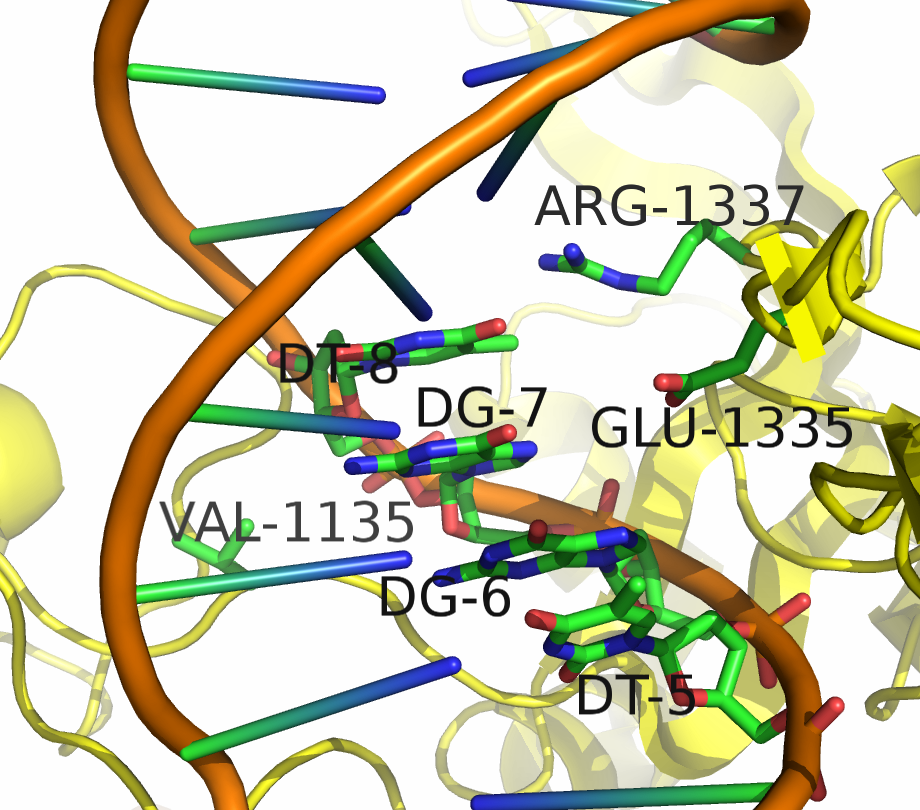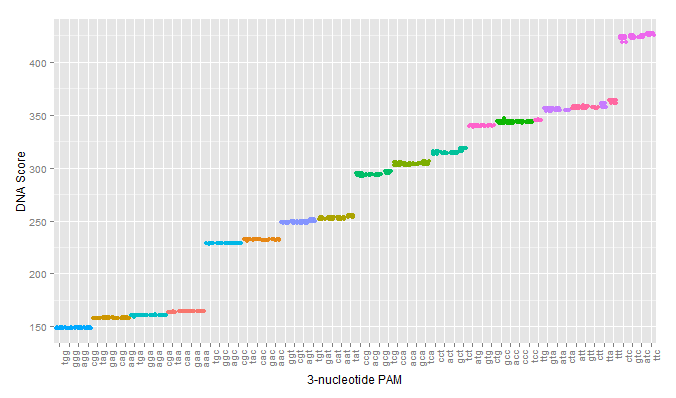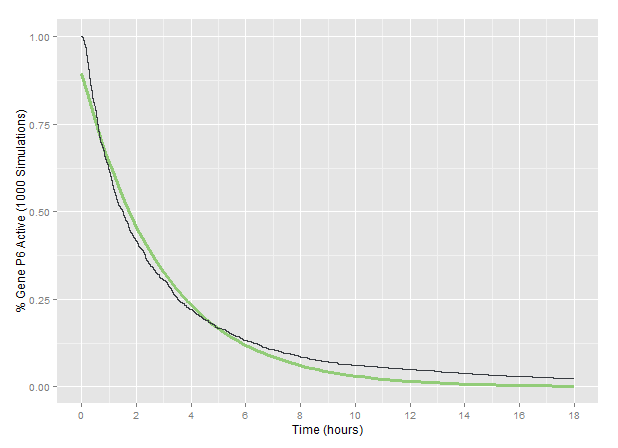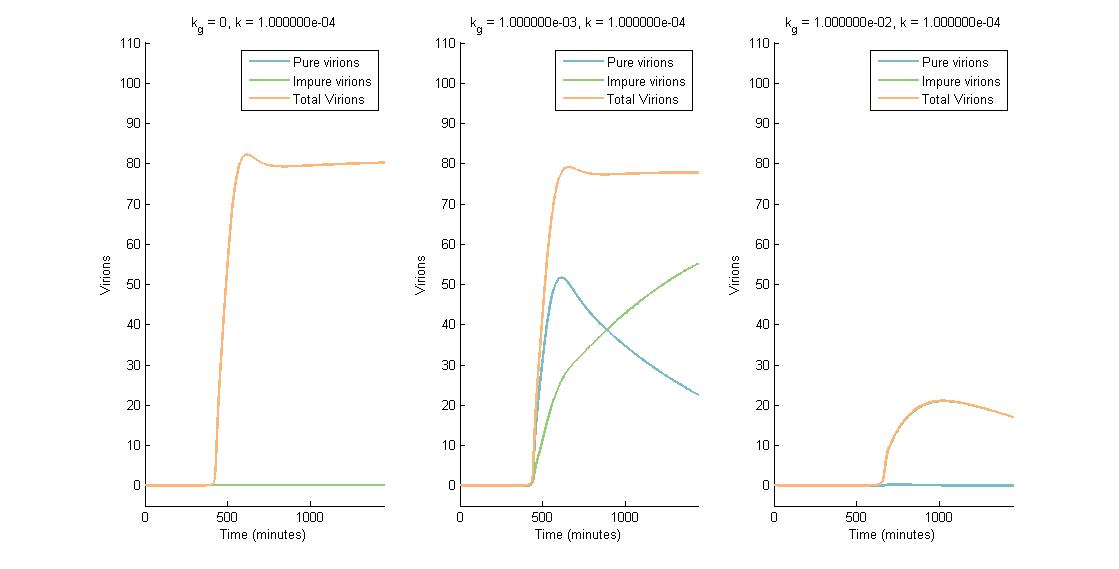Difference between revisions of "Team:Waterloo/Modeling"
m (Added replication time-series graphs) |
|||
| Line 13: | Line 13: | ||
</section> | </section> | ||
</section> | </section> | ||
| − | + | <h2>PAM Structural Bioinformatics</h2> | |
| − | + | <p> A key limitation of the current use of S. pyogenes Cas9 for gene editing is the inability to target sequences which are not adjacent to a NGG PAM sequence. To overcome this issue, we developed a pipeline to probe Cas9 mutants with altered PAM specificity using simulation tools in PyRosetta and Python. A detailed description of the analysis and software used in this work can be found on the <a href="https://2015.igem.org/Team:Waterloo/Modeling/PAM_Flexibility">Modeling Engineered Cas9 PAM Flexibility</a>. </p> | |
| − | <p> | + | <div class="row"> |
| + | <div class="col-sm-6"> | ||
| + | <figure> | ||
| + | <img src="/wiki/images/0/0d/Waterloo_VQR_mutated_residues.png" alt="Cas9 with a mutated residues indicated" class="img-responsive""/> | ||
| + | <figcaption>A PyMOL generated image of the three mutations found in the VQR spCas9 variant.</figcaption> | ||
| + | </figure> | ||
| + | </div> | ||
| + | <div class="col-sm-6"> | ||
| + | <figure> | ||
| + | <img src="/wiki/images/b/bd/Waterloo_wt_original_64_BC_BD_variance.png" alt="The docking scorings of wildtype spCas9 in PyRosetta to the 64 PAM variants" class="img-responsive""/> | ||
| + | <figcaption>The docking scorings of wildtype spCas9 in PyRosetta to the 64 PAM variants.</figcaption> | ||
| + | </figure> | ||
| + | </div> | ||
| + | </div> | ||
| + | <p> The simulation managed to successfully predict the PAM specificity of wild type spCAs9. However, validation against known Cas9 mutants was less successful, predicting a mix of correct and incorrect, though biochemically similar, PAM sequences.</p> | ||
</section> | </section> | ||
</section> | </section> | ||
<section id="antiviral" title="Plant Defense"> | <section id="antiviral" title="Plant Defense"> | ||
<h2>CRISPR Plant Defense</h2> | <h2>CRISPR Plant Defense</h2> | ||
| − | <p> To model antiviral application, looked at the antiviral effects of CRISPR/Cas9 targeting on three scales: CaMV genomes, plant cells and plant leaves. A background primer on Cauliflower Mosaic Virus (CaMV) genetics, replication and spread can be found on the <a href="https://2015.igem.org/Team:Waterloo/Modeling/CaMV_Biology">CaMV Biology page</a>.</p> | + | <p> To model antiviral application, we looked at the antiviral effects of CRISPR/Cas9 targeting on three scales: CaMV genomes, plant cells and plant leaves. A background primer on Cauliflower Mosaic Virus (CaMV) genetics, replication and spread can be found on the <a href="https://2015.igem.org/Team:Waterloo/Modeling/CaMV_Biology">CaMV Biology page</a>.</p> |
<div class="row"> | <div class="row"> | ||
<div class="col-sm-4"> | <div class="col-sm-4"> | ||
| Line 57: | Line 71: | ||
<p>The ODE model was then scaled up to the level of <strong>plant leaves</strong>. We modeled the spread of infection between plant cells using an agent-based framework, which is described in detail on the <a href="https://2015.igem.org/Team:Waterloo/Modeling/Intercellular_Spread">Intercellular Viral Spread</a> page. The agent-based model allowed us to explore the effect of intercellular defense signalling (which leads plant cells to resist to infection and become suseptible to apoptosis).</p> | <p>The ODE model was then scaled up to the level of <strong>plant leaves</strong>. We modeled the spread of infection between plant cells using an agent-based framework, which is described in detail on the <a href="https://2015.igem.org/Team:Waterloo/Modeling/Intercellular_Spread">Intercellular Viral Spread</a> page. The agent-based model allowed us to explore the effect of intercellular defense signalling (which leads plant cells to resist to infection and become suseptible to apoptosis).</p> | ||
| − | |||
| − | |||
</section> | </section> | ||
Revision as of 03:53, 19 September 2015
Modeling
Mathematical modeling is a core part of Waterloo iGEM: we have nearly as many team members typing furiously away in our dry lab as we do wrangling transformations in our wet lab. This year, we created models in Python, MATLAB and NetLogo that examine the feasibility of our design and provide tools for assessing future designs. The code for each model is available on our GitHub and details on the formulation of each model may be found in the pages linked below.
Cas9 Frameshift Dynamics
Some visual representation of the model and ~100 words about what it contributed to our project, with a link to the CRISPR/Cas9 Frameshift Dynamics page.
PAM Structural Bioinformatics
A key limitation of the current use of S. pyogenes Cas9 for gene editing is the inability to target sequences which are not adjacent to a NGG PAM sequence. To overcome this issue, we developed a pipeline to probe Cas9 mutants with altered PAM specificity using simulation tools in PyRosetta and Python. A detailed description of the analysis and software used in this work can be found on the Modeling Engineered Cas9 PAM Flexibility.


The simulation managed to successfully predict the PAM specificity of wild type spCAs9. However, validation against known Cas9 mutants was less successful, predicting a mix of correct and incorrect, though biochemically similar, PAM sequences.
Overall, our multi-scale model of CRISPR Plant Defense allowed us to investigate the extent to which we could slow CaMV spread using CRISPR/Cas9 and its interaction with host defense systems such as RNA interference and intercellular defense signalling.




